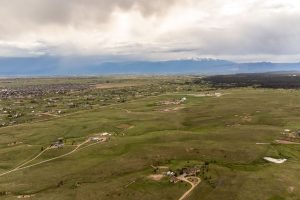Construction is currently underway for Colorado Springs Utilities’ largest so-lar power facility to date.
The 175-megawatt facility, called Pike Solar, is located in eastern El Paso County and will boast more than 400,000 photovoltaic panels spanning across about 1,310 acres, according to statements released by Colorado Springs Utilities and the power supplier, Duke Energy Sustainable Solutions.
The project is scheduled to reach completion by late 2023 and will produce enough electricity to provide power to about 46,300 homes, according to a state-ment released by Duke Energy Sustainable Solutions.
Steve Berry, senior public affairs specialist at Colorado Springs Utilities, said, “We can start integrating power generated by Pike Solar as soon as it comes online. The resource is integrated into our overall grid and is available to all of our electric customers.”
After Pike Solar is integrated into Colorado Springs Utilities’ system, renewable energy sources such as solar, wind and hydro resources are estimated to rep-resent about 27% of Colorado Springs Utilities’ overall energy portfolio, Berry said.
In addition to increasing the representation of renewable energy in the over-all energy portfolio, Pike Solar will also be a significant step in the right direction to help CSU reach their goal of reducing carbon emissions 80% by 2030.
But Pike Solar isn’t the only factor driving CSU toward reaching this goal.
“Just by closing both of our coal-fired power plants by 2030, we’ll be well on our way to achieving the 80% carbon emissions reduction by 2030,” Berry said. “In fact, we ceased burning coal at the downtown Martin Drake Power Plant back in 2021 and permanently closed the plant in September 2022. The Ray Nixon Power Plant, just south of Colorado Springs, will be closed prior to 2030.”
CSU is also looking into adding between 100 to 200 megawatts of battery storage by 2025, Berry said. “This will not only help us maximize the efficiency of our renewable sources, but also our entire electric generation portfolio.”
Berry attributes regulatory requirements and customer input as primary motivators in the timing of this energy source transition.
Multiple bills, such as Senate Bill 19-096, House Bill 19-1261, and Senate Bill 19-236, were signed into Colorado law in 2019 in an effort to reduce green-house gas emissions. “The new laws required us to reduce carbon emissions by at least 80% by 2030 and 90% by 2050,” Berry said. “This was not attainable without moving away from coal-based generation. Failure to comply with these regulations could have resulted in costly fines and prescribed remedies by the state.”
With this in mind, it’s no surprise that Colorado Springs Utilities isn’t the only electrical company working hard to be green. Falcon’s local cooperative, Mountain View Electric Association, is also on track to make changes in the realm of renewable energy.
It’s important to first note the way that Mountain View Electric Association operates. Mountain View Electric Association Chief Executive Officer Ruth Marks said, “Mountain View Electric Association is a distribution cooperative; we pur-chase electricity from our power supplier, Tri-State Generation and Transmission, also an electric cooperative. As Tri-State is Mountain View Electric Association’s wholesale power supplier, any policy or change that impacts Tri-State has a poten-tial to impact Mountain View Electric Association members.”
In 2022, an average of about 34% of all energy consumed by Tri-State’s members was renewable, said Lee Boughey, vice president of communications at Tri-State. Moving forward, it is expected that 50% of the energy Tri-State’s mem-bers consume will come from renewable energy by 2025; and, by 2030, that num-ber will increase to 70%.
“Through Tri-State, Mountain View Electric Association powers over 53,500 members with a mix of energy sources,” Marks said. “Because of Tri-State’s renew-able resource mix, all members, including homes and businesses in Falcon, are partially powered by renewables today. Mountain View Electric Association tracks the number of renewable interconnections in our service territory, which is over 2,800 and counting. In just the Falcon area, we have 450 interconnected members who produce two megawatts of energy a year. To give some perspective, that’s about the capacity of three Walmarts.”
Currently, Tri-State provides renewable power to its members through nine wind and solar projects, as well as federal hydropower and multiple smaller hydro-power projects across the region, Boughey said.
But that number will soon go up.
“Six additional solar projects are expected to be constructed to serve Tri-State’s members by 2025,” Boughey said. “Tri-State will be significantly growing its solar resources, adding more than 700 megawatts of solar by 2025.”
And the solar expansion might not stop there. Marks said, “As an electric co-op that serves members throughout a 5,000-square-mile service territory, serving eight counties, in a state that boasts of ‘300 days of sunshine,’ the Mountain View Electric Association Board of Directors is interested in exploring the opportunity to develop a solar project to self-supply power for our electric load, and possibly a community solar program.”
MVEA is actively seeking a RFP for solar energy. The RFP will assist MVEA in its evaluation of solar energy resources to be built and operated in MVEA’s ser-vice territory in the next two to three years.
“This is an exciting time in the electric industry,” Marks said. “What seemed impossible 20 years ago is now much more attainable, especially in the areas of electric use management, residential solar (net metering), community solar, bat-tery storage, electric vehicle support and high-speed fiber broadband services. For members who have an increased interest in these areas and would like to see an expansion of services, you have been heard. We are actively taking steps for the benefit of our membership.”




